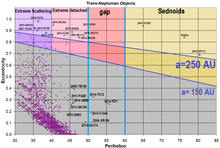(612911) 2004 XR190
It was first observed on 11 December 2004, by astronomers with the Canada–France Ecliptic Plane Survey at the Mauna Kea Observatories, Hawaii, United States.
With a perihelion of 51 AU, it belongs to a small and poorly understood group of very distant objects with moderate eccentricities.
The team included Brett Gladman, John Kavelaars, Jean-Marc Petit, Joel Parker and Phil Nicholson.
[4] It belongs to the same group as 2014 FC72, 2014 FZ71, 2015 FJ345 and 2015 KQ174 (also see diagram), that are poorly understood for their large perihelia combined with moderate eccentricities.
The theories include close stellar passages, unseen planet/rogue planets/planetary embryos in the early Kuiper belt, and resonance interaction with an outward-migrating Neptune.
